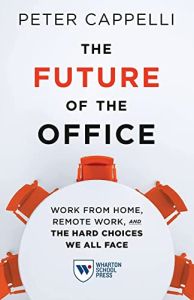Melden Sie sich bei getAbstract an, um die Zusammenfassung zu erhalten.

Melden Sie sich bei getAbstract an, um die Zusammenfassung zu erhalten.
Peter Cappelli
The Future of the Office
Work from Home, Remote Work, and the Hard Choices We All Face
Wharton School Press, 2021
Was ist drin?
How to return people to the office is as important as whether to do so.
Recommendation
Companies are deciding whether to bring staff back to the office, go fully remote or create hybrid workplaces. Peter Cappelli warns that this decision requires considering significant variables that could affect retention, productivity and corporate culture. He cites baseline and current research, and explains the trade-offs of various models. Though COVID-19 forced many firms to have only remote workers in 2020 and 2021, today every firm and employee can determine whether remote or onsite works best for them. Cappelli outlines options, risks and rewards in this robust look at the issues you must ponder to determine where your workforce – or you – should work.
Summary
About the Author
Peter Cappelli is a professor at the Wharton School and director of its Center for Human Resources.























Comment on this summary